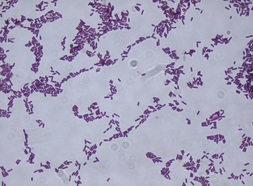 Bacillus subtilis
Bacillus subtilis First, the 20 minute number comes from a typical lab bacteria, E. coli, grown under ideal lab conditions of temperature, pH, sufficient nutrients, and a carbon source (energy) from glucose - which is "bug candy". Unlike my pure lab E. coli culture, a wastewater unit has many different species of microbes including gram positives, gram negatives, heterotrophic, chemotrophic, obligate aerobic, facultative anaerobic, and even some anaerobic cultures (in some systems). This mix of bacteria forms the MLSS with each organism functioning in various ecological niches as a consortia. We refer to this mix of living bacteria, extracellular materials, and adsorbed particles as MLSS, floc, or biofilm depending upon the system.
So how fast do these bacteria grow? Well each strain has a different maximum growth rate. Most common heterotrophic (BOD/COD degraders in wastewater) have a doubling time of 30 - 60 minutes. Slower growing organisms appear under adverse conditions (a whole other topic) and are known as r-rate strategists. More delicate cultures such as ammonia oxidizing bacteria have a doubling time measured in hours, which makes them more susceptible to washout and slow to recovery from a toxic shock event.
Also, the numbers above are for growth with ideal medium under lab conditions. In wastewater, we usually operate in much lower F/M conditions which further slows growth. We usually monitor microbial growth/activity using oxygen uptake rates and ATP. When oxygen uptake rates are high and free ATP is present in the solution, we are experiencing rapid growth. This of course is not ideal for operating a waste treatment plant. As the respiration rates drops and free ATP decreases, we start to see a reduction in cellular growth. Eventually entering the range of ideal F/M conditions where effluent quality is optimal.
So while bacteria can grow very fast under lab conditions, they rarely achieve 20 minute doubling times in wastewater. In fact, we only see max growth rates during startup or following a shock loading. Even then, it takes longer than 20 minutes for the bacteria to double given the nature of wastewater.

 RSS Feed
RSS Feed